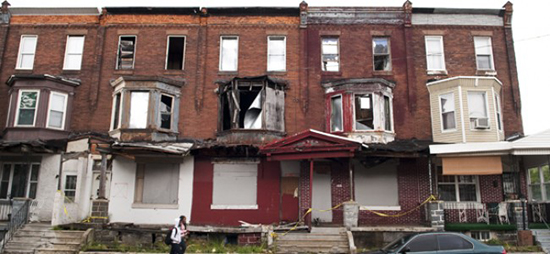Addressing New York’s Urban Blight
 |
|
Urban blight, addressed by a UAlbany-hosted conference, is a national problem, consuming cities' resources, decreasing neighborhood market values and directly affecting public safety and economic development.
|
ALBANY, N.Y. (April 21, 2016) — A nationally recognized expert on urban blight, speaking to a packed crowd in the Performing Arts Center, said that blight is not the actual cause of problems in communities, “but rather a symptom of underlying social and economic problems. Once you get in the cycle of urban blight, it gets that much harder to solve.”
Alan Mallach of the Center for Community Progress in Washington, D.C., noted that solving this increasingly persistent and costly problem for New York’s cities, including cities in our region, is a multi-faceted issue with multiple forces that both shape the problem and influence the strategies to address them.
Mallach keynoted the forum, “The Impact of Blight on Communities: Definitions, Effects & Programs,” convened by UAlbany’s Center for Technology in Government (CTG), the Nelson A. Rockefeller Institute of Government, and the Center for Urban Studies at the University at Buffalo.
He was joined by a panel of both research and practice experts including Schenectady Mayor Gary McCarthy, Nora Yates of the New York Governor’s Office, George Galster of Wayne State University, Henry Louis Taylor of UBuffalo’s Center for Urban Studies, and Susan VanDeventer of the Office of the State Comptroller.
Several of the panelists noted that the place to start with solutions to urban blight is to have each city’s data in hand.
“Solving urban blight is dependent on data,” said Mallach. “If you don’t have good data — for example, about the properties, the owners, foreclosure status, etc. — you’re basically flying blind.”
Blighted and vacant properties in cities consume resources, decrease neighborhood market values and directly affect public safety and economic development. The path to creating 21st Century remedies, agreed the speakers, involves gaining a holistic view of the forces that create blight, and then inspecting case examples how other communities have addressed the issues — learning from both from efforts that have worked, and those that failed.
Theresa Pardo, CTG director and the panel’s moderator, said the Center “is committed to working with cities throughout the world to help them think strategically about a variety of pressing public problems — urban blight being an incredibly important one. This forum gathered renowned experts who each brought a different perspective, allowing the discussion to be comprehensive and thorough.”
The forum was an outgrowth of CTG's work with four Capital Region cities on addressing the problem of urban blight through regional information sharing. With funding from the NYS Department of State, the cities of Schenectady, Troy, Amsterdam, and Gloversville have partnered with CTG to address code enforcement information needs throughout the region.
The event was simulcast for attendees at UBuffalo as well as webcasted.
Raising Awareness through Art
Urban blight is an increasingly growing issue in cities across the country. In an effort to bring further attention to it, Adam Frelin, a professor in UAlbany’s Department of Art and Art History, and lead architect Barbara Nelson, AIA, are launching Breathing Lights, one of four winners in the nationwide $1 million Bloomberg Philanthropies Public Art Challenge.
Breathing Lights will illuminate roughly 300 empty buildings in Albany, Schenectady, and Troy, between 6 and 10 p.m. in October and November, with lights that dim and glow to emulate the breathing of a living being. The installation aims to regenerate interest in once-vibrant neighborhoods with high vacancy rates.
Once uninstalled, most buildings will be up for sale.
![]() For more news, subscribe to UAlbany's RSS headline feeds
For more news, subscribe to UAlbany's RSS headline feeds
A comprehensive public research university, the University at Albany-SUNY offers more than 120 undergraduate majors and minors and 125 master's, doctoral and graduate certificate programs. UAlbany is a leader among all New York State colleges and universities in such diverse fields as atmospheric and environmental sciences, business, education, public health,health sciences, criminal justice, emergency preparedness, engineering and applied sciences, informatics, public administration, social welfare and sociology, taught by an extensive roster of faculty experts. It also offers expanded academic and research opportunities for students through an affiliation with Albany Law School. With a curriculum enhanced by 600 study-abroad opportunities, UAlbany launches great careers.


